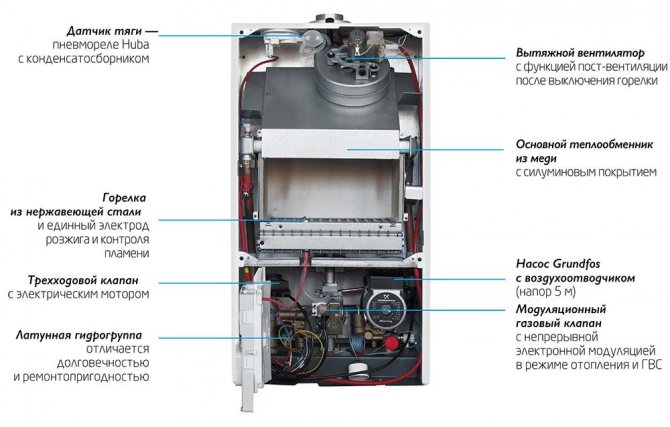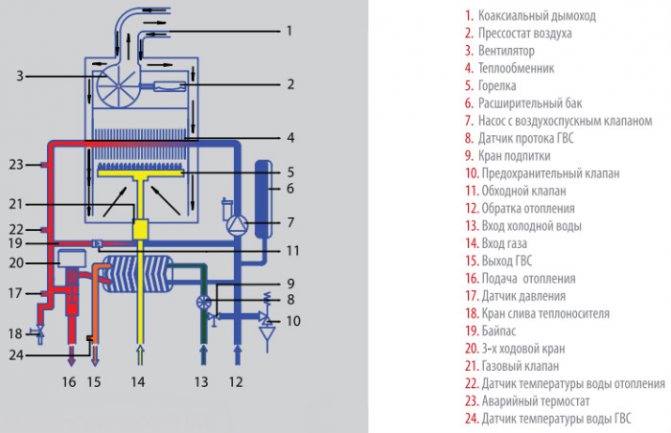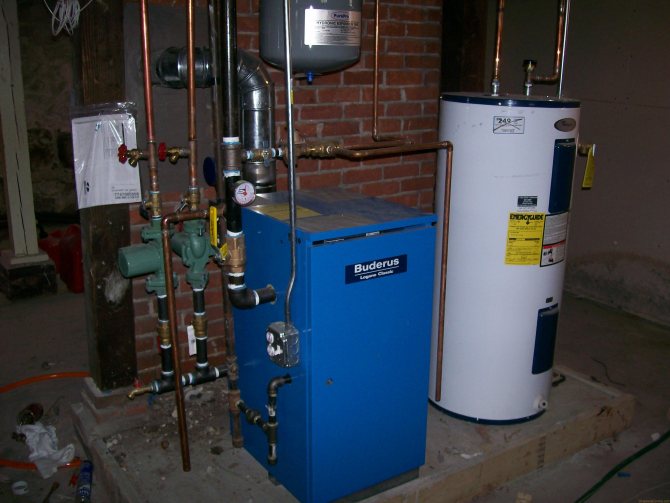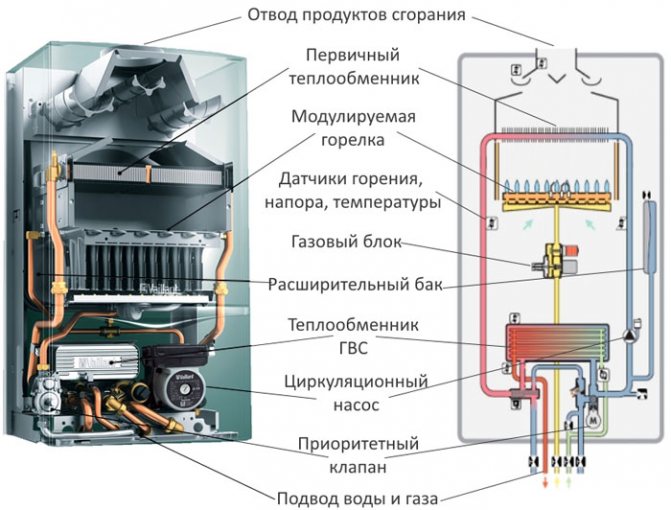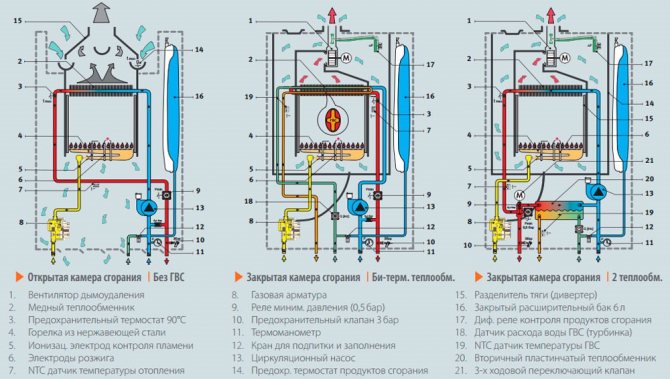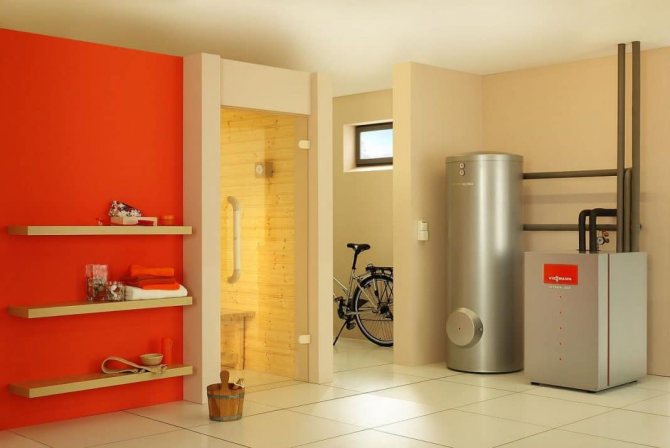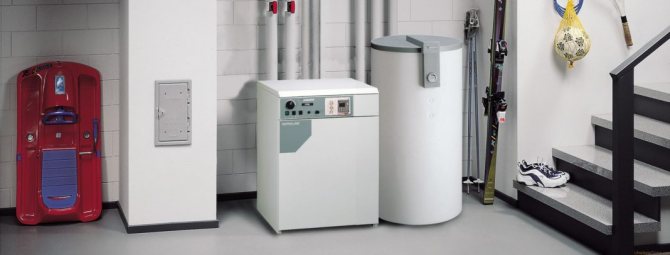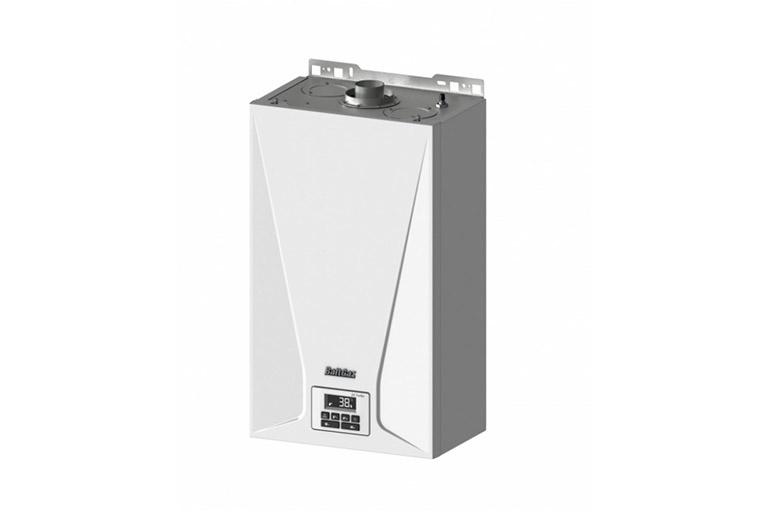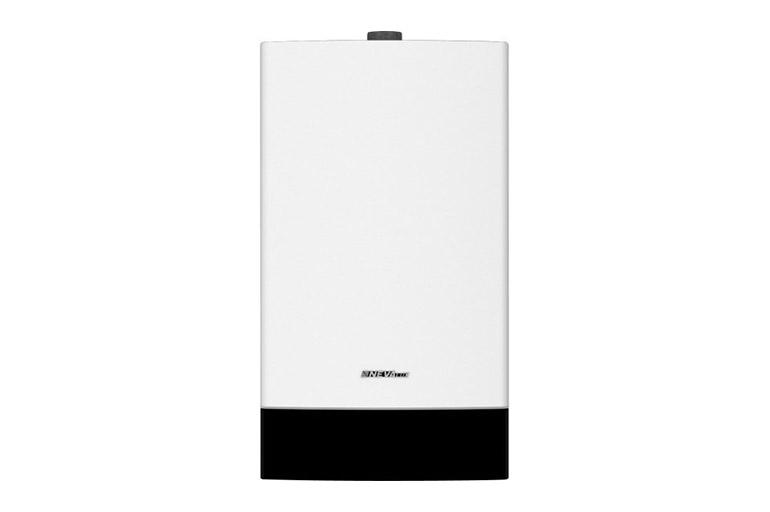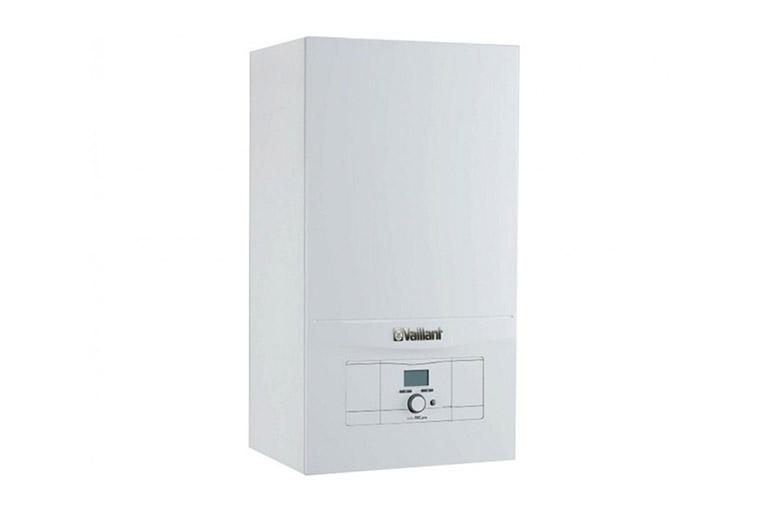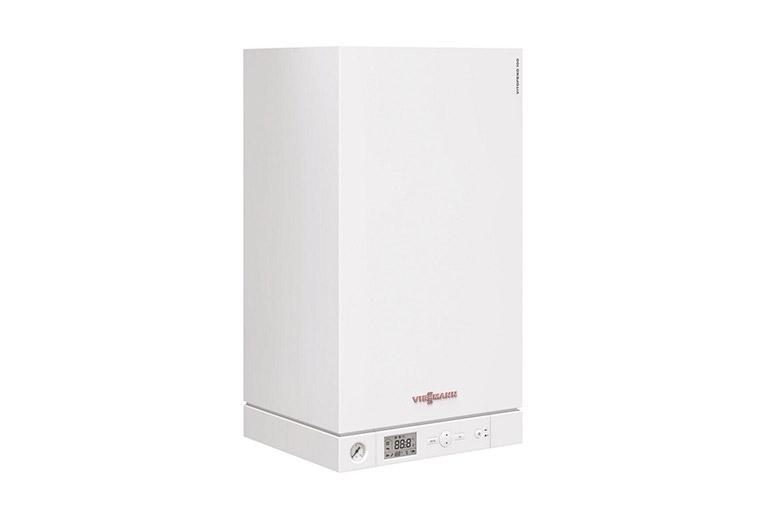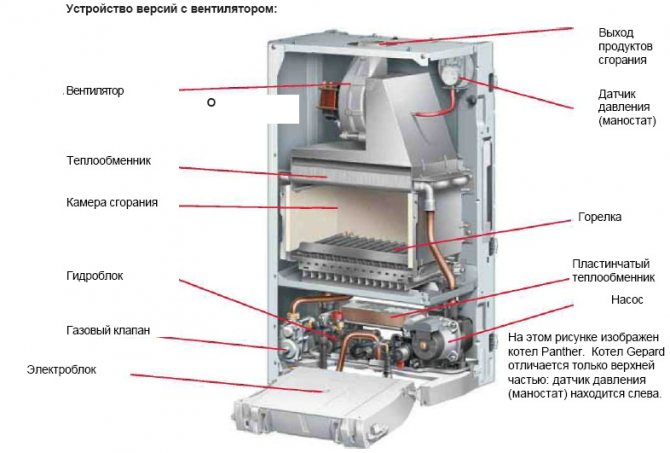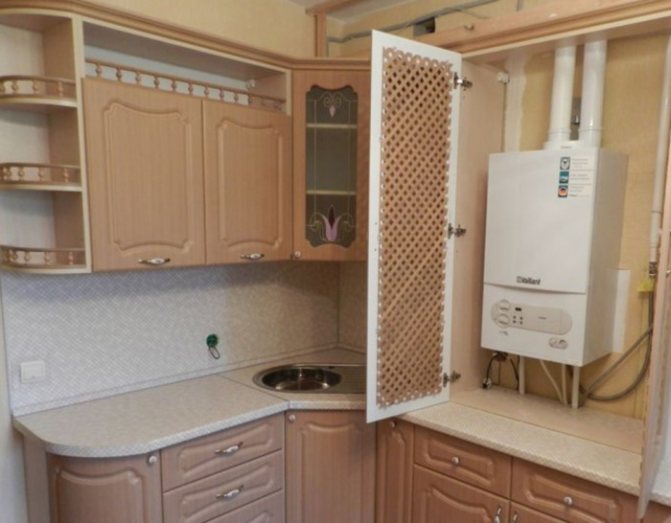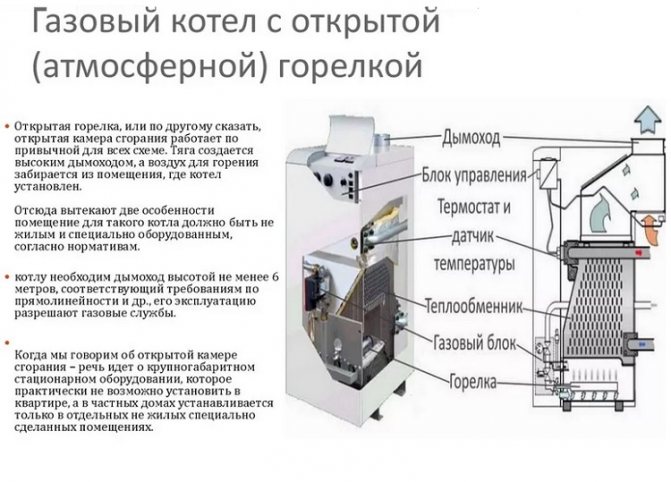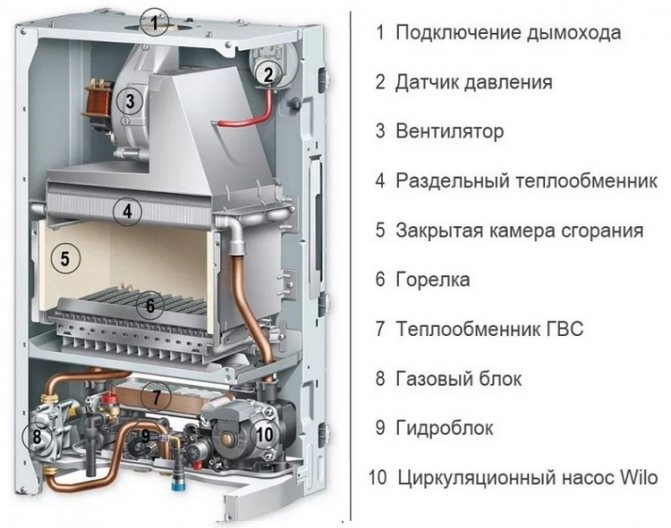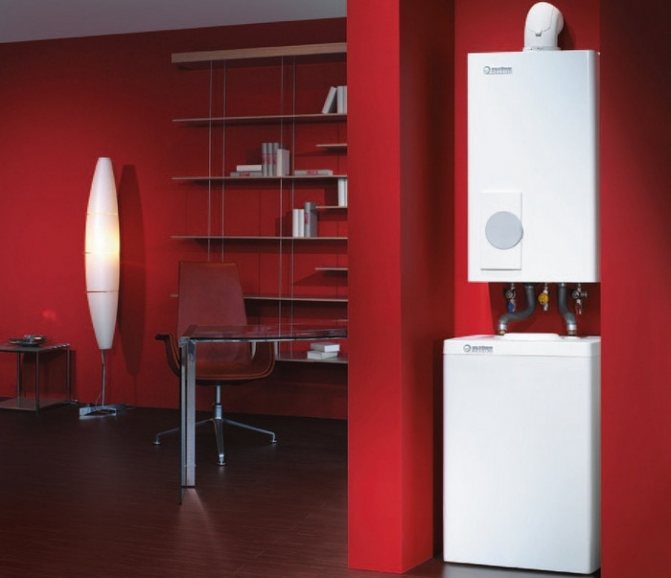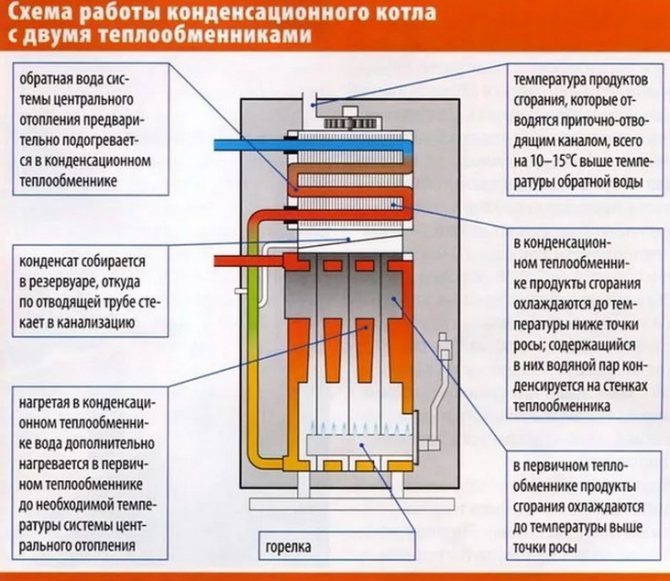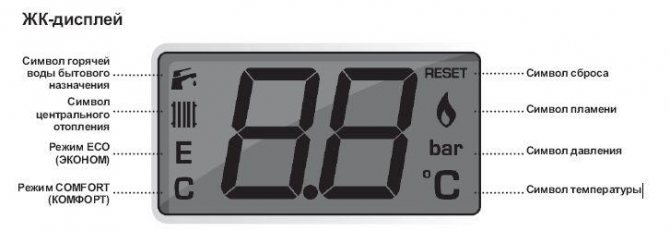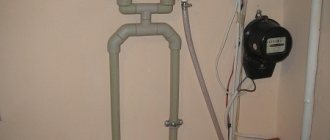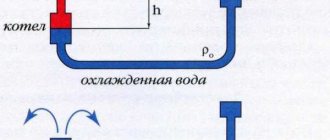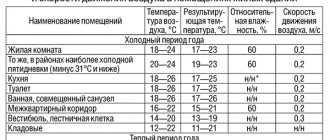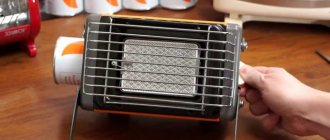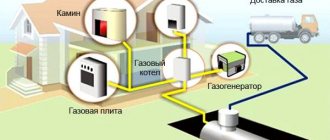Home / Gas boilers
Back to
Published: 22.06.2019
Reading time: 4 minutes
0
805
A turbocharged boiler by its design differs from the atmospheric one in the way that air is supplied to the burner and the combustion products are removed. They can be placed on the floor and on the wall, there are single and double-circuit gas turbine boilers.
- 1 The principle of operation of a turbocharged boiler
- 2 Advantages of turbo boilers
- 3 Disadvantages
- 4 Turbocharged or naturally aspirated?
- 5 Floor standing turbo boilers
- 6 Wall mounted turbo boilers
- 7 Best manufacturers of turbocharged boilers
- 8 Installation rules
The principle of operation of a turbocharged boiler
The name "turbocharged" means that the boiler has a turbine, that is, a fan that supplies air, maintains combustion and removes combustion products. The design assumes a closed type of combustion and a smoke exhaust system with several turns.
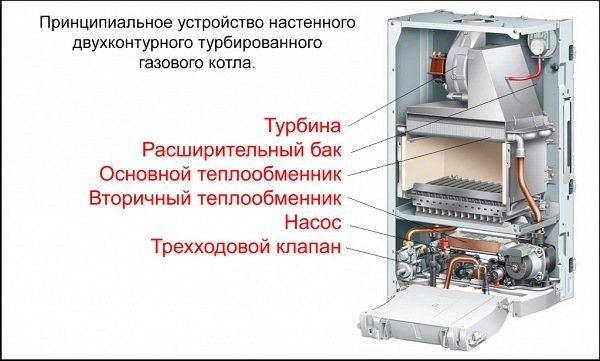
When the fuel burns, a certain amount of heated gases is released. To increase efficiency through increased heat transfer, the design provides for the passage of these gases through the channels where they give off their heat, increasing the efficiency. Thus, it is possible to reduce the temperature of the exhaust gases to 100-120 ° C. To understand how a turbocharged gas boiler works, you need to understand how equipment with a closed combustion type works.
Such units are connected to a coaxial chimney or to a pipe-in-pipe system: the inner pipe is used to remove gases, and the annular space is used to supply outdoor air. In equipment of this type, air circulation and smoke removal is carried out using a fan, the intensity of which depends on the gas pressure. It is connected to automation.
When the gas pressure changes in the system, the automation sends a signal to change the rotation speed. However, it should be understood that the system is characterized by noise and in order to reduce its level, at the beginning of the boiler operation, you need to set the minimum mode. The control of the turbine operating mode makes it possible to regulate the degree of heating.
Features of the chimney device
The coaxial flue system of a turbocharged gas boiler has two channels. The "pipe in pipe" device allows providing several processes at the same time: drawing in combustion air from the street and removing exhaust gas outside. At the same time, thanks to the special design of the boiler, the combustion air flows through the chimney directly into the combustion chamber.
To increase productivity, the coaxial chimney is equipped with an electric turbine. The rotation speed of the blades can be adjusted. This function is very important in case of pressure drops in the main pipeline, as it equalizes the ratio of components in the gas-air mixture. That is, it can be done so that the rotation of the turbine corresponds to the gas pressure. Thanks to this design feature, the boiler burner operates throughout the heating season with maximum heat transfer.
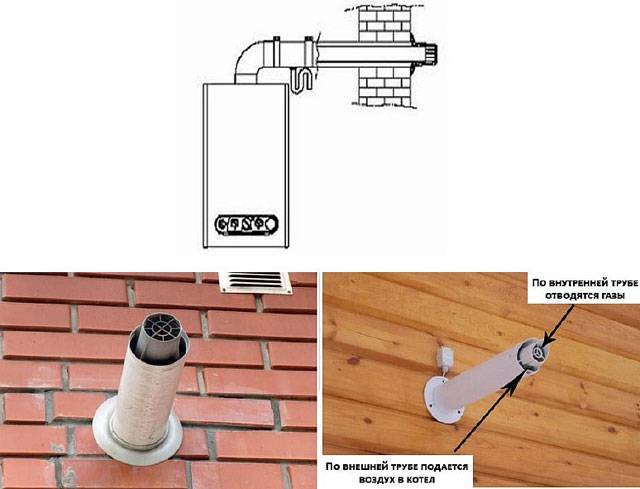

The turbo boilers are equipped with automatic sensors that control the safe operation of the unit. In the event of an accident, they will instantly turn off the system and cut off the gas supply.
The gas double-circuit turbo boiler does not require the installation of a large chimney structure, therefore its installation is greatly simplified. There is no need to build a separate boiler room, because it does not take oxygen from the combustion room. Such a boiler can be installed both in residential and non-residential buildings and structures.
Advantages of turbo boilers
The use of turbocharged gas boilers is associated with both positive and negative aspects.
The advantages of the equipment include:
- easy installation in any convenient place;
- air intake from the street, which does not affect the violation of the indoor climate;
- the presence of a modulation burner device adapted to operate at low fuel pressure;
- transition to liquefied gas is possible;
- the presence of automation that regulates the combustion mode depending on the weather;
- smoke exhaust without the likelihood of harmful gases entering the home.
In general, turbocharged gas installations have no analogues in terms of economy and efficiency.
Benefits
Inflated devices have a number of features that allow them to be used there. Where it is impossible or difficult to install other types of wall-mounted or floor-standing boilers.
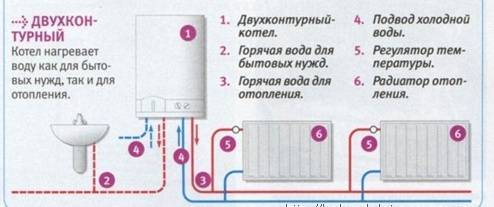

The consumers of the turbo boilers appreciated the following qualities:
The design features of the turbo boiler make it the most cost-effective. When compared with other types of heating equipment. The relatively small dimensions of the coaxial chimney and ease of installation allow the use of many modifications of turbocharged heaters in those rooms where it is unacceptable or impossible to install other equipment. The air intake for maintaining the process is not made from the room itself. At the same time, there is no danger of the release of toxic gases in the absence of oxygen and incomplete combustion of the fuel. One of the main advantages is the compact size of the boiler. Pressurized gas boilers have an efficiency level of about 95%. This is ensured by automatic control over the entire work process. In this case, the most optimal parameters of the installation are set. The use of a coaxial chimney is the most cost-effective compared to other models
At the same time, the organization of a stationary chimney is not required, it is very important when installing heating in an already populated apartment or house
The wall unit can even be installed in a bathroom or kitchen due to its safety and dimensions. At the same time, he will not create additional difficulties or inconveniences.
disadvantages
Among the disadvantages of turbocharged gas boilers are:
- use of electricity. Boiler automation and turbine depend on electricity;
- with regular power surges in the network, the automation may fail;
- condensation is present. Since the temperature of the flue gases does not exceed 120 ° C, condensation forms in coaxial chimneys, which can block the duct when freezing.
To solve the latter problem, the chimney is usually insulated and a condensate collector is installed.
The best known manufacturers and models: characteristics and prices
BAXI ECO-4s 24F
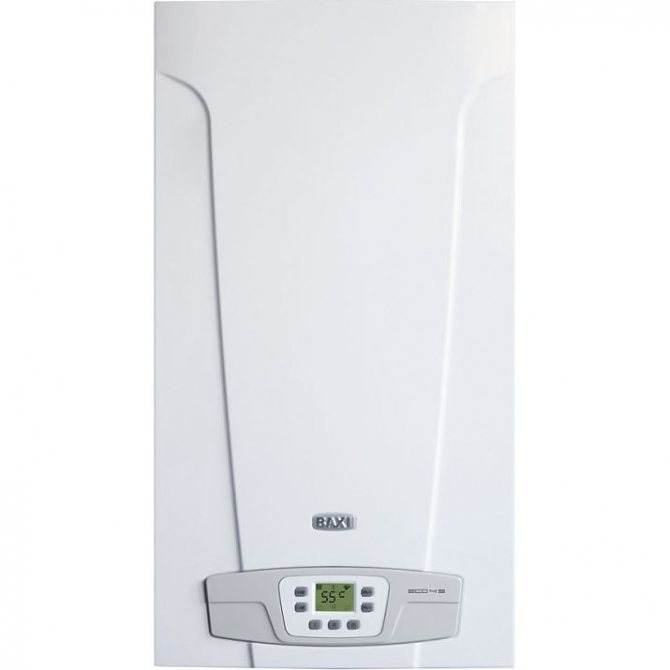

The Italian double-circuit turbo boiler with a capacity of 24.0 kW was developed taking into account the specifics of Russian conditions, therefore it is adapted to work with low gas pressure, power outages and other unstable indicators. It also has one of the best efficiency in its price segment - 92.9%, while gas consumption is 2.54 m3 / h. The primary heat exchanger is made of copper.
The owners note the almost silent operation, for more than 5 years of operating practice, there were no serious service complaints.
Cost: 33 110 - 36 850 rubles.
Manufacturer: BAXI (BAXI), Italy.
Vaillant turboTEC pro VUW 242 / 5-3
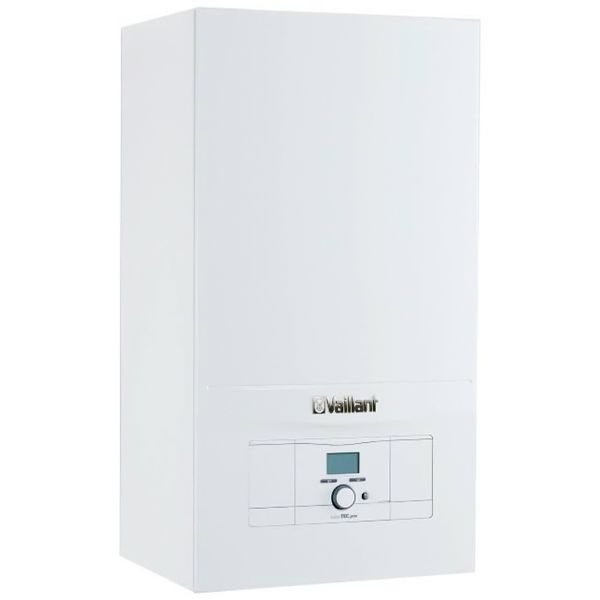

Dual-circuit model from the reference German brand with a capacity of 24 kW. Differs in particular reliability and durability due to excellent build quality, use of high-tech alloys and the best materials. Efficiency 91%, maximum gas flow 2.80 m3 / h. It also features a copper primary heat exchanger, modulating burner, functional automation with many protective systems and a pleasant, stylish design.
Cost: RUB 53,920 - RUB 57,860.
Manufacturer: Vaillant (Vailant), Germany (assembled in Slovakia).
Viessmann Vitopend 100-W A1HB001
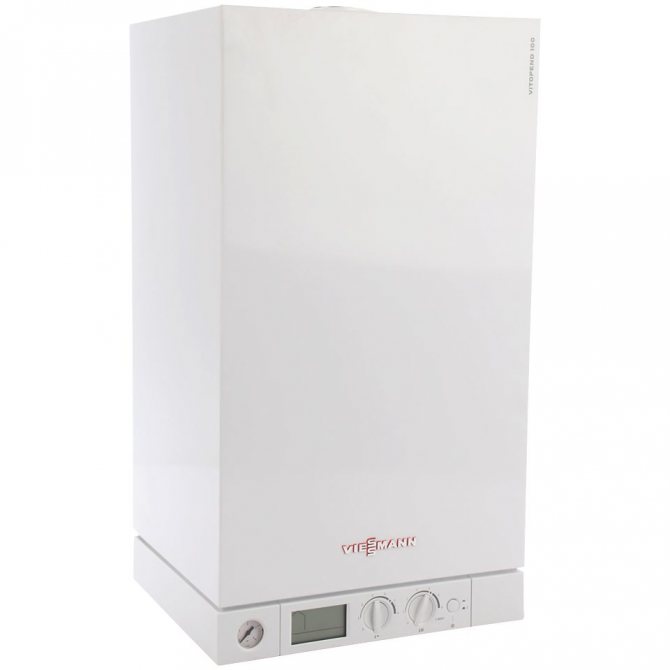

One of the best gas turbocharged boilers for heating a private house and another reference German model with a capacity of 24 kW. Like the previous Vaillant turboTEC, it is distinguished by its high reliability and durability, while the boiler is absolutely not picky about the quality of the coolant and the pressure in the gas main. Efficiency - 91%, maximum gas consumption - no more than 2.77 m3 / h.
A serious advantage is the presence of a programmer that allows you to set the boiler operation settings for the next day or week, for example, setting the temperature to 15 ° C during working hours when the owners are not at home, which will significantly reduce operating costs.
The only common problem is that the boiler shuts down due to icing in the chimney at temperatures below -17-18 ° C. The solution is to monitor the condition of the chimney and promptly knock down ice, insulate its outer part or install an anti-icing structure.
Cost: 36,010 - 43,550 rubles.
Manufacturer: Viessmann (Wiesman), Germany.
Buderus Logamax U072-24
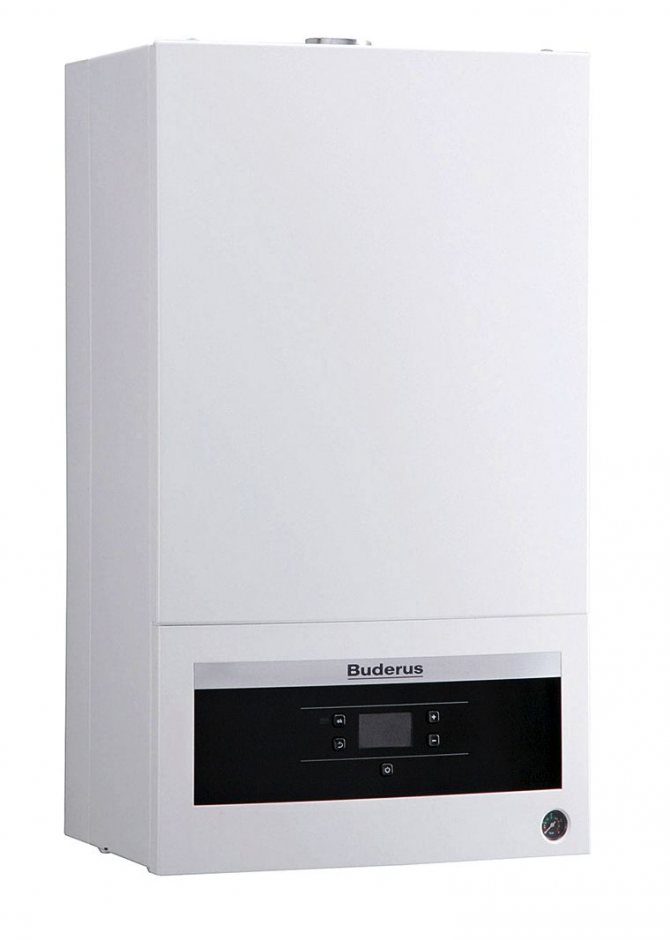

Wall mounted turbocharged gas boiler with a capacity of 24.0 kW. In fact, this is another reference German model, but with Russian localization, which made it possible to significantly reduce its cost and distinguish it from its analogues. The efficiency is 92%, the maximum fuel consumption is 2.8 m3 / h. The boiler is also equipped with a copper primary heat exchanger, modulated by a burner.
The only drawback is the lower Russian build quality, which is not typical for other German and Italian models.
Cost: 27 950 - 34 820 rubles.
Manufacturer: Buderus (Buderus), Germany-Russia.
Navien GA 23KN
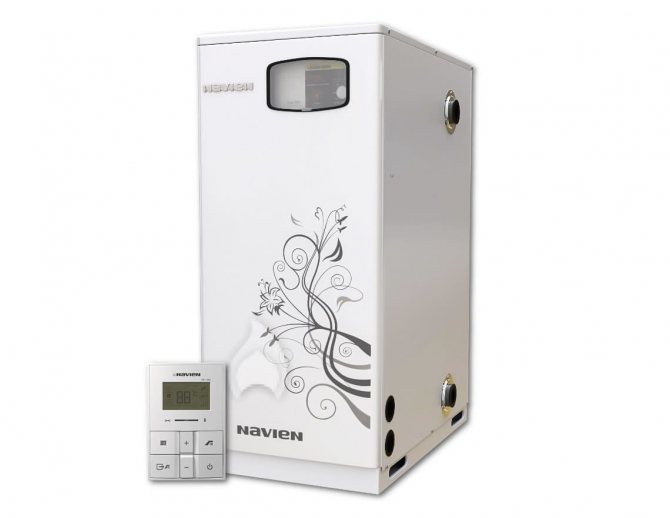

The floor-standing two-circuit turbo boiler with a capacity of 23.0 kW has a modest gas consumption of 2.24 m3 / h. It is equipped with a unique protection against voltage surges: with a difference of ± 30%, the SMPS chip is triggered on the microprocessor, which allows you to continue working without the risk of damaging the electronics. At the same time, the boiler is equipped with a modulating burner, a programmer, a room thermostat and a remote control are already included in the factory configuration.
Perceptible disadvantages are the steel heat exchanger, mediocre build quality, noisy, relative to the above models, work.
Cost: 32 980 - 36 140 rubles.
Manufacturer: NAVIEN (NAVIEN), South Korea (often with Russian assembly).
Turbocharged or naturally aspirated?
When the buyer is faced with the choice of which boiler is better to choose: turbocharged or atmospheric, all the features of their design and operation should be considered. The main difference is that in an atmospheric boiler, the process of fuel combustion occurs in an open manner with natural air exchange, therefore such equipment is often called convection. Such boilers are connected to a standard chimney, and air for the combustion process is taken from the boiler room.
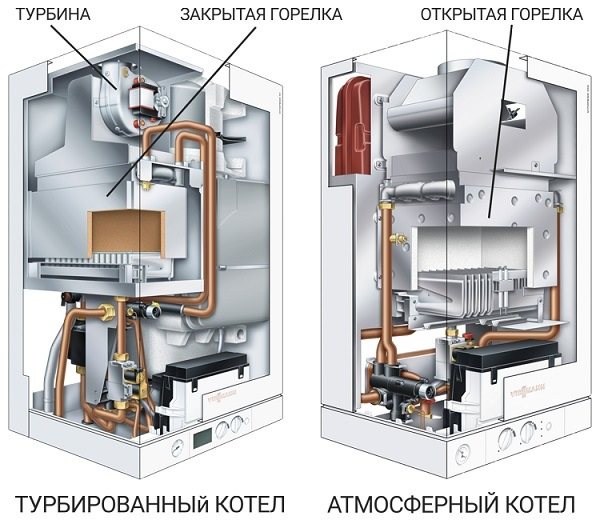

When using atmospheric boilers, there is an increased gas consumption and strict installation requirements, regulated by SNiP. Also, atmospheric equipment must not be used in multi-storey buildings and during installation, the cabinet must not be covered with decor. In a turbocharged boiler, the combustion chamber is closed. Forced air exchange and flue gas removal by means of a turbine are applied. During operation, air from the furnace is not used for fuel combustion.
Therefore, the norms are allowed to install such equipment in small rooms, decorating the case, near the counter. Turbocharged gas boilers are connected to a coaxial chimney, which serves both for the intake of outside air and for the removal of combustion products.
Therefore, the main difference in comparison with atmospheric boilers is forced air exchange and smoke removal.
What are turbocharged gas boilers
Turbocharged gas boiler - the unit responsible for heat supply, which is additionally equipped with a forced air exchange system. Due to this feature, it does not require the arrangement of a full-fledged smoke shaft, since communication with the external environment occurs through a coaxial chimney.


A coaxial chimney is a one-piece construction (usually supplied with the boiler), consisting of pipes of different diameters, nested one inside the other. Oxygen is taken through the outer channel (large pipe), and waste products of combustion are removed through the central (smaller pipe).
Since the high-quality ventilation of the room itself is not important for turbo boilers, they can be installed both in private houses and in city apartments.
The main and, perhaps, the only significant disadvantage is that, due to the presence of a turbine and more complex automation, they are extremely volatile.
Device and principle of operation


The basic structure of the turbo boiler is not much different from its predecessor, but the presence of auxiliary units introduces some changes in its design.
The air necessary to maintain combustion enters from the street directly into the closed combustion chamber. Since it is isolated from the living space and is directly connected only to the coaxial chimney, this completely excludes any influence of the exhaust gases on the internal microclimate.
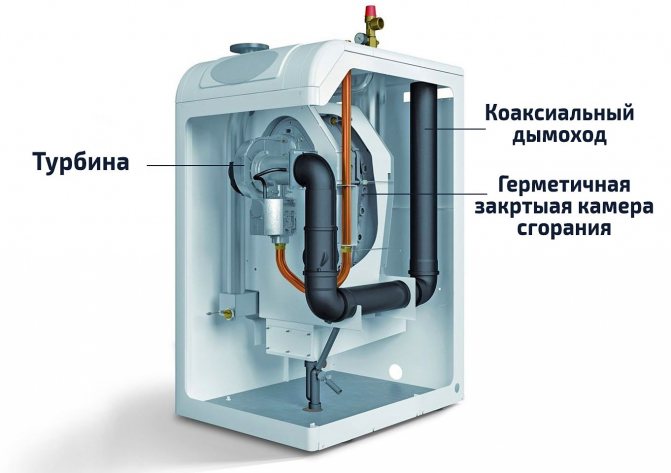

The device is a turbocharged floor model.
The fan (turbine) provides smoke removal outside the house without the use of exhaust fans, creating excess pressure (turbocharging).
The rotation speed of the turbine fan is automatically controlled, therefore, even with a decrease in gas pressure in the main line, the composition of the gas-air mixture remains optimal. When the power changes, the speed is instantly selected, which will provide the required amount of air and proper traction. Thus, the best conditions for the operation of the burner are observed, allowing to obtain the greatest amount of energy from the fuel.
How to choose a room thermostat and save up to 30% per month on heating
Atmospheric or turbocharged: which is better
A traditional atmospheric boiler has an open combustion chamber: air intake for gas combustion comes from the room. This means that the consumed oxygen must be fully replaced with new one. This requires supply and exhaust ventilation.
Without the organization of good supply and exhaust ventilation, normal operation of an atmospheric gas boiler is impossible. Firstly, the fuel will not be able to completely burn out and, as a result, the coolant will not receive a certain amount of heat, and secondly, life-threatening carbon monoxide (CO) - carbon monoxide - forms in the room.
Therefore, for small buildings, where it is problematic to separate a ventilated boiler room with a vertical chimney separate from the living area, it is better to choose a turbocharged boiler. And for gas heat supply of small retail space, offices and typical high-rise buildings, so it is generally the only option.
Floor standing turbo boilers
Floor standing turbo boilers generally have high power and are reliable in operation.
When choosing a floor-standing option, the following characteristics should be analyzed:
- heat exchanger material (cast iron or steel). Cast iron is more reliable and durable (up to 35 years), but steel is cheaper;
- number of circuits: can be single-circuit and double-circuit. Some models have a built-in container for preparing hot water. If there is no need for DHW, then a single-circuit floor boiler can be used, which copes well with heating large rooms, since there is no energy consumption for DHW.
The disadvantage of floor-standing turbocharged boilers is the size. This is important when placing it in a small area.The advantage is reliability, all units and parts of the boiler are made of durable materials due to the absence of weight restrictions. Such boilers are used for about 5 years longer than wall-mounted ones.
Rules for removing smoke in turbocharged gas units
The exhaust gases from turbocharged gas boilers must only be discharged through a coaxial chimney. To install it correctly, the following requirements must be met:
- the pipe should be located horizontally with a slight slope towards the street; if the boiler is condensing, the slope should be towards the unit so that the condensate can drain into the condensate receiver;
- the chimney should be installed in accordance with the requirements of the instructions attached to the device;
- the pipe is placed 1.5 m above the combustion chamber;
- they put on protection against the ingress of debris and insects on the head of the pipe;
- the maximum length of the horizontal section of the chimney is 3 m, but some manufacturers make the chimney 5 m;
- the distance from the pipe to window and door openings must be at least 0.5 m; to the window above the chimney - 1 m;
- in a wooden house, a gap of 5 cm should be left between the pipe and the wall, it is filled with basalt wool;
- you cannot arrange more than 2 swivel knees.
Some manufacturers equip their gas boilers with a coaxial chimney. If this is not provided, then it is better to choose a pipe of the same manufacturer as the heating device. The suitable diameter of the coaxial chimney for a particular turbocharged unit model is indicated in the instructions. The design of the pipe must have a closable hole to be able to clean it from soot and a condensate trap that is led down the drain.
Note! In exceptional cases, if the chimney cannot be brought out horizontally, the chimney is installed vertically in compliance with technical requirements.
Wall mounted turbo boilers
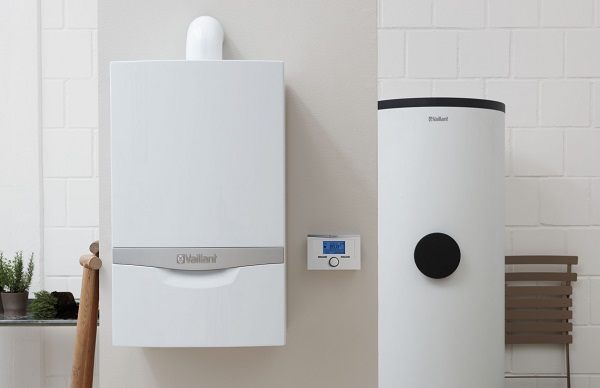

Photo: idroclimaterm.it
Wall-mounted turbocharged boilers are very common, as they are compact, have a beautiful design and are easy to install.
Wall-hung boilers have the following features:
- simple installation and connection;
- fast heating. Despite the fact that water is heated in a flowing way, it happens instantly;
- weather-dependent automation, modulating burner.
The most popular are double-circuit turbocharged boilers, since single-circuit boilers are convenient for use only for heating non-residential buildings.
How to choose a turbocharged gas boiler for heating a private house
Wall-mounted or floor-mounted
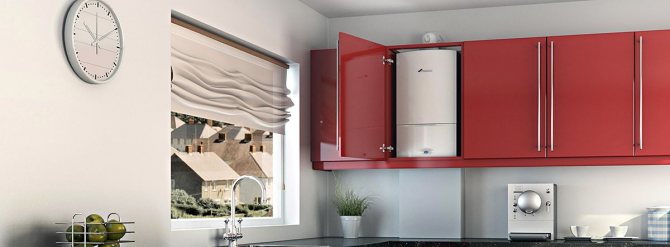

Wall-mounted models fit perfectly into the interior of the kitchen or can be completely hidden in the closet.
- floor - more versatile and durable, since the structure is unlimited in weight, they are often equipped with durable cast iron heat exchangers .;
- hinged (wall) - compact and lightweight, medium and low power (10-50 kW) boilers, often having a higher efficiency than floor-standing models. However, due to weight requirements, they use less corrosion-resistant steel and copper heat exchangers.
In addition, wall-mounted boilers contain all the necessary modules of the heating system in one housing (expansion tank, circulation pump, safety valve, air vent, etc.), which not only simplifies, but also makes installation cheaper. Floor standing models are rarely equipped with all the necessary modules.
Single-circuit or double-circuit
The functionality of a turbo boiler is determined by the number of circuits:
- single-circuit - its capabilities are limited exclusively by heating;
- double-circuit - along with heating it heats water for domestic needs.
A double-circuit boiler is a combination of a boiler and an instantaneous heater, i.e. the heating of the room is stopped when hot water is supplied.It is worth clarifying that, contrary to popular belief, the coolant does not have time to cool down during the downtime, so the temperature in the dwelling remains the same.
Of course, the cost of the double-circuit version is 10-30% higher, but it is still more profitable than organizing hot water supply in any other way, for example, using a boiler and a single-circuit boiler. And if necessary, one of the circuits can be turned off - for example, in the summer, when there is no need to heat the dwelling.
Heat exchanger type and material
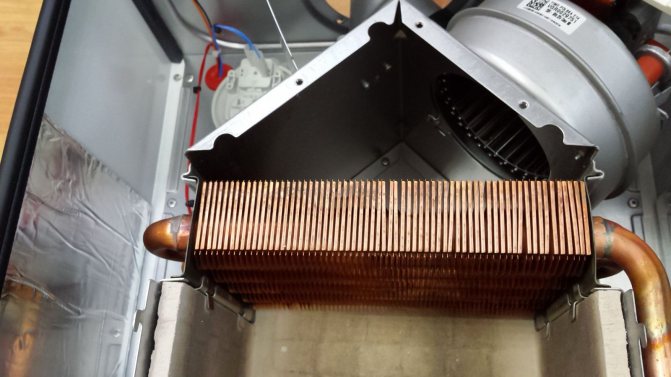

A copper heat exchanger is the most optimal option for a wall-mounted model.
The material of the heat exchanger affects the durability of the boiler:
- cast iron (service life 25-30 years and more) - the most heat- and corrosion-resistant metal, but fragile and heavy, therefore it is used only in floor-standing models;
- copper (service life 12–17 years) - very light and heat-conducting metal (it quickly heats up and cools down), slightly corrosive, but can burn out.
- steel (service life 10-15 years) - the metal tolerates transportation well, since it is not sensitive to physical stress, light and inexpensive to manufacture, but is prone to rust formation, which leads to leakage over the years.
Double-circuit boilers are also divided according to the type of heat exchanger: separate (for each circuit its own) and double - bithermic (the DHW circuit passes through the main heat exchanger). The latter option is cheaper, but it is less reliable, since the scale formed in it is almost impossible to clean, it is the clogging with scale that often causes premature breakdown.
Efficiency
Despite the fact that the atmospheric (90–92%) and turbo boilers (92–95%) have “pure” efficiency practically the same, the latter will have a higher gas consumption efficiency.
The point is to use a coaxial chimney: when cold air from the street enters its outer cavity, it begins to heat up even before entering the combustion chamber from the heat of smoke (100-130 ° C), which comes out through the inner cavity of the same chimney. Therefore, fewer resources are spent on further heating. To this it is worth adding more efficient control of air flow and traction, which also affects gas consumption.
Minimum required power
You can calculate the required power of a turbo boiler using a simple formula: where 1 * kW of energy goes to 10 m2 of heated area.
* heat loss of an average residential building with ceilings up to 2.7 m from central Russia.
For example, for a standard house in the Moscow region with 2 bricks masonry and a ceiling height of 2.7 m, an area of 120 m2, the minimum suitable power of a turbo boiler will be Q = 120 ÷ 10 × 1 = 12 kW.
We recommend setting a margin of 15–20% of this value in order not to operate the unit at the limit, therefore, for the same object, Q≈14–15 kW.
Also, if we consider a two-circuit model, then the use of hot water supply will have to add at least 15–20%, in total it will already turn out that Q≈16–17 kW. It is also important not to overdo it with power, otherwise the boiler will “clock” (turn on and off) too often, which will reduce its resource.
How to accurately calculate the required boiler power Individual calculation, formula and correction factors
The best manufacturers of turbocharged boilers
The most popular and high-quality equipment is produced by German firms. Italian and French companies follow. A number of Russian enterprises have mastered the production of turbocharged boilers, and their quality is approaching the level of world brands.
The first in the quality rating is the products of the companies: Buderus, Bosch Gas, Protherm, Vaillant... Slightly inferior to them: Baxi, Neva Lux, Arderia.
Next are the slightly inferior Korean brands: Navien, Daewoo, Kiturami, Hydrosta.
Boiler device
Double-circuit turbo boilers are equipped with a heat exchanger and heating circuits. The first one is closed with the heating system.The second is not in contact with the heating. When the DHW valve opens, the coolant does not rush into the heating system of the house, it enters the DHW circuit. The water in the second heat exchanger is heated by the first heat exchanger and then supplied to the taps. When the DHW system is turned off, the reverse switching is carried out.
To figure out which boiler is needed for certain conditions, you need to figure out what are the differences between different devices. Gas boilers differ in the following characteristics:
- execution option;
- principle of operation;
- view of the combustion chamber.
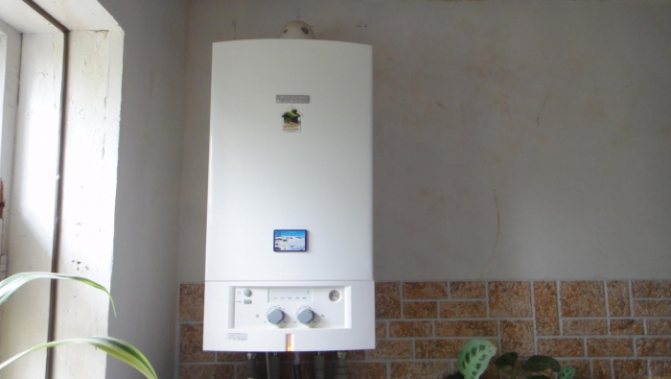

Attention! Heating equipment should also be selected by manufacturer. Ariston products are of high quality.
Boilers can also differ in the way they work. They are carried out by condensation and convection. In the latter case, the water vapor that appears during combustion escapes along with the smoke. Popular among European manufacturers.
Condensing boilers have a different design, in which the combustion products, together with steam, are sent to a heat exchanger, where the steam begins to condense.
There are several advantages of convection boilers. They have a fairly simple device. At the same time, there is no condensation and the possibility of rust. As a result, the cost of the product is significantly reduced. Also, such devices have one serious advantage - combustion products are removed due to natural draft.
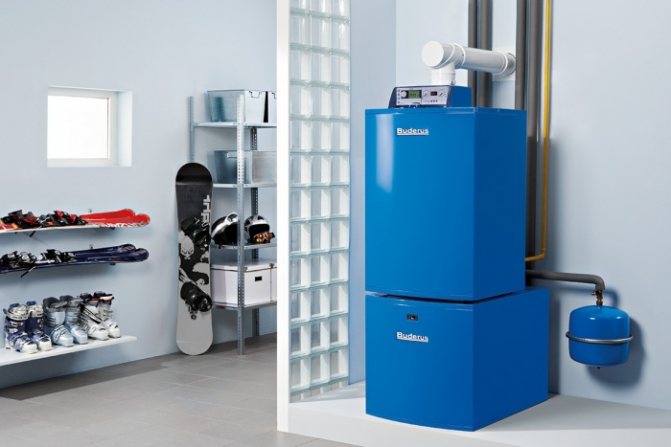

Condensing wall-mounted double-circuit boilers are distinguished by high efficiency due to the use of the latent heat of steam. One of the disadvantages of such a device is the presentation of certain requirements to the heating system. One of the main conditions for steam condensation is the low temperature of the heat exchanger. For this reason, the coolant must enter it already cold. To provide the required heating, expensive radiators must be used. When choosing conventional radiators, the efficiency of the device will be lower than stated.
Advantages of an atmospheric boiler
Chimney gas boilers are the most common option for organizing autonomous heating. They are relatively inexpensive, easy to operate, and have a solid resource. The principle of operation of an atmospheric boiler provides for the evacuation of combustion products by natural draft, which is organized by the chimney. Among the advantages of the equipment are the following:
- low price;
- there are completely autonomous models, without electricity;
- the presence of a draft sensor guarantees the safe operation of the combustion chamber.
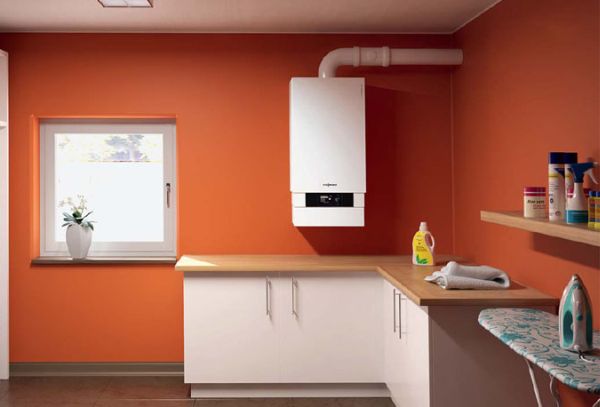

Operation of double-circuit products
It is worth returning to the question of choosing a boiler. For which cases is the unit with one, and for which - with two circuits more suitable? Many might argue that the answer is obvious. Double-circuit gas boilers perform 2 functions at once. They both heat the room and allow the use of hot water.
However, it is worth considering situations in which the presence of such functions is not required. For example, if the house is connected to the central water supply. Also, during the operation of the boiler, when heating water for hot water supply, the coolant in the heating system cools down. If more functionality is required from the heating equipment, it is better to choose a double-circuit wall-mounted boiler.


As soon as the choice in favor of a particular type of design is made, one should begin to consider the characteristics of the product. Attention should be paid to the heating power as well as the DHW performance. The standard characteristic of such devices is 24 kW. Boilers "Ariston" and "ProTerm" are more popular in the market of heating products.
Approximate figures can be obtained when taking into account the area of heated rooms. For example, for heating 1 m3 of housing, it is necessary that a wall-mounted double-circuit gas boiler has an average power of 100 W.This figure is quite good considering that the room is surrounded by heated rooms. The ceilings in it should be no higher than 3 m. If these conditions are not met, the required power can be raised to 150 W per 1 m3. by multiplying this figure by the area of the house or apartment, you can get the required boiler power. Usually, products with a capacity of 24 kW are chosen for country houses.
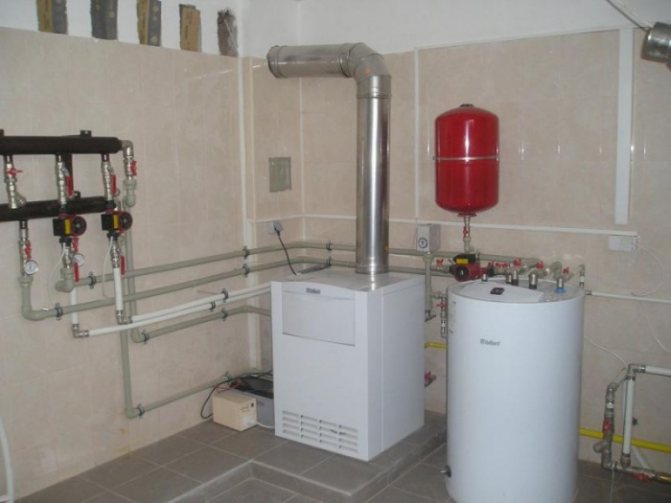

The DHW capacity is also fairly easy to calculate. All calculations can be done independently. Typically, a conventional tap consumes approximately 400 liters of heated water. The product data sheet usually indicates the capacity in l / min. The above figure corresponds to the figure of 6 l / min. If there are 2 or more points, you should think about purchasing a more productive device. the more popular Ariston products on the modern market.
In addition, the performance indicator depends on the temperature difference between cold and hot water. Such an indicator can be found in the data sheet. A suitable example can be given. The house may have 2 hot water consumption points. In this case, the cold temperature is +10 degrees. A comfortable indicator is +40 degrees. In this case, the boiler must have a capacity of 13.2 l / min at ∆t 30 ° C. If households have other needs and conditions, the boiler performance is determined in the same way.
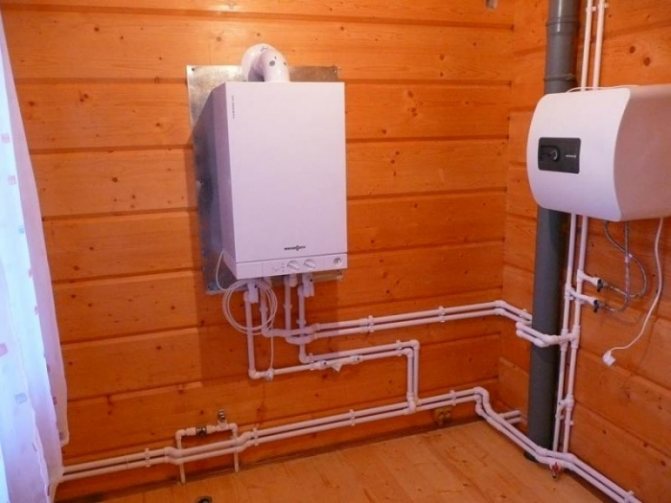

When calculating the total power, the already figured out indicator of the power that is needed for heating should be taken into account. You will also need to calculate the power that provides the DHW performance. Closed chamber boilers provide the best performance. Usually they are performed with a capacity of 24 kW.
The main criteria for choosing a boiler
When choosing a boiler with an atmospheric gas burner, it is necessary to pay attention to the following main characteristics:
- Power;
- Number of contours;
- Installation method - floor or wall-mounted;
- The material from which the heat exchanger is made;
- Automation and safety
Let's dwell on each of the criteria in more detail, and consider all the main points related to the given technical characteristics, with the exception of those that have already been considered above.
Power
The quality of heating operation and the creation of a comfortable temperature in the room largely depend on the power of the boiler.
When calculating the boiler power, you need to take into account:
- Room area;
- Room volume;
- Coefficient of thermal conductivity of walls, windows and doors.
In order not to dive deeply into numbers and calculations, you can take a different, simpler path. It is generally accepted that for heating 10 square meters of housing, 1 kW of boiler power is enough for standard 2.5 m high ceilings and room insulation. Thus, it is enough to divide the area of the room by 10, and we get the theoretically required boiler power.
The resulting figure must be increased by 20% in order to ensure the normal operation of the boiler during the period of peak loads. To obtain a sufficient volume of hot water, which is especially important for instantaneous double-circuit boilers, the power must be increased by 25%.
Material
The main materials from which the heat exchanger of the atmospheric boiler is made are cast iron, steel, stainless steel and copper. The cast iron heat exchanger has almost no power limitations. It is distinguished by its reliability and durability due to its excellent anti-corrosion properties.
But here, too, it has its own peculiarities - cast iron can crack due to the temperature difference at the point of water entry and the heating zone. Design solutions provide for the prevention of low temperature corrosion by installing a four-way valve.
Cast iron heat exchangers are installed in floor standing boilers. Products are distinguished by their large dimensions and weight.
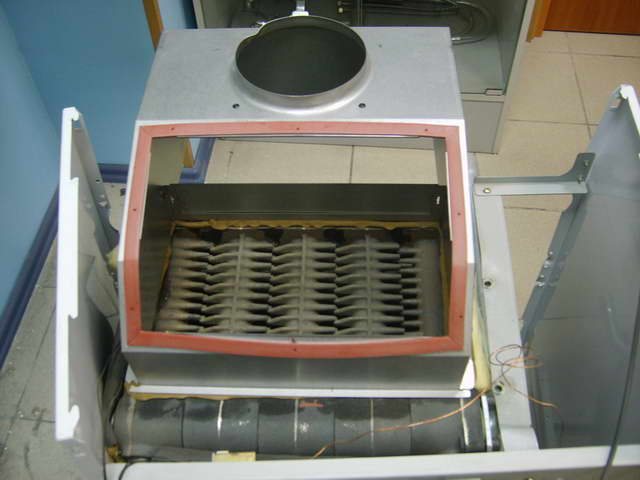

The cast iron heat exchanger has no restrictions on the boiler power, it is the most reliable and durable
Steel heat exchangers are used by domestic boiler manufacturers due to their low cost. Such heat exchangers are not demanding for installation, they resist thermal loads well, but at the same time they are significantly inferior to cast iron heat exchangers due to their low resistance to corrosion.
A good alternative to steel is a stainless steel heat exchanger. It combines all the positive qualities of steel and cast iron - it is durable, immune to thermal shock, and has high corrosion resistance. But at the same time, boilers with stainless steel heat exchangers are distinguished by a higher cost.
Copper is plastic and conducts heat well. The heat exchangers made of it have many fins and are characterized by a small volume, due to which it is possible to achieve a reduction in the size and weight of the boiler.
Copper heat exchangers are used in wall-hung boilers, provide quick heating, which reduces fuel consumption. Due to the compactness and small amount of water, a circulation pump is required to avoid boiling.
Automation and safety
Automation ensures the safety of the boiler, economical fuel consumption, and improves the level of comfort during the operation of the equipment. The cost of automation for a gas boiler is determined by the number and complexity of programs and functions.
Some of them are considered basic and should be present in any gas boiler. They are responsible for preventing gas leakage as a result of various non-standard situations - flame damping, gas pressure drop.
There are two types of automation - volatile and non-volatile. The first is considered the most reliable, but requires an electrical connection and an uninterruptible power supply. The second is considered mechanical, it is simpler and autonomous.
Installation requirements
The highest demands are placed on the installation of atmospheric boilers. Installation and connection is carried out only by representatives of the gas company, with which an agreement is concluded for further maintenance and technical inspection of the equipment. All connecting nodes must be perfect, extremely tight.
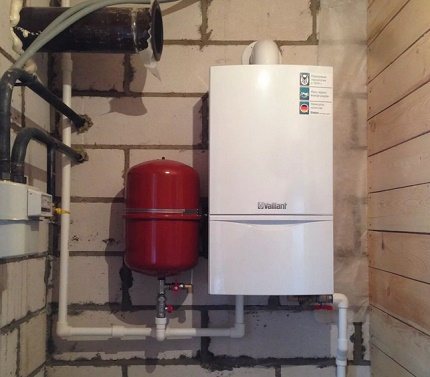

The turbocharged boiler can be installed independently. But it must be borne in mind that the slightest violation will lead to a decrease in performance, and the manufacturer will refuse warranty service
Turbocharged models are not so demanding, but hand-wired connection is also not particularly recommended. Especially if, through the fault of an inexperienced contractor, water gets into the gas pipeline. There is an important condition - the flawless removal of the chimney ducts to the street.
Gas boiler efficiency
First you need to find out what the efficiency of an atmospheric boiler is. Many knowledgeable people do not pay attention to these letters, but only look at the power. This is fundamentally not true, since the efficiency of the boiler shows how much of the generated energy will be used to heat the water, and how much will evaporate. That is, efficiency is useful energy that is used for its intended purpose.
The efficiency of atmospheric gas boilers varies between 80-90%, that is, 10-20% of the energy will “warm” the street.
The efficiency directly depends on the boiler model and its cost. More expensive modern boilers regulate the gas supply in such a way as to get the maximum effect.
It is worth noting that the efficiency of turbocharged boilers is 90-97%, and that of condensing boilers is above 100%. The only difference is that the "exhaust" of an atmospheric boiler has an average temperature of 110 ° C, turbocharged - 55 ° C, and condensing - about 30 ° C.
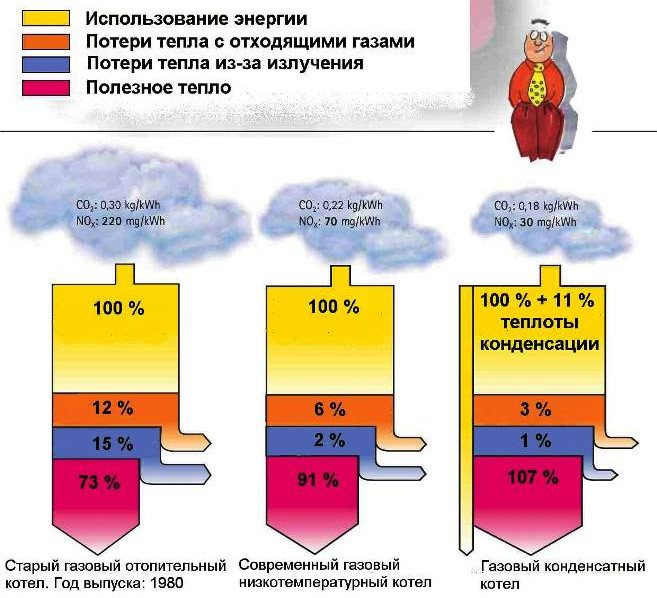

Weight and dimensions
Almost all wall-mounted boilers have standard dimensions - 700 x 400 x 250 mm, and their weight varies from 25 to 50 kg. Weight and dimensions depend not only on power, but also on additional elements, such as a touch panel, temperature sensors, an additional chamber for heating running water, and so on.It makes no sense to focus on the choice of an atmospheric boiler in terms of weight and dimensions, since most boilers, regardless of power and efficiency, have standard dimensions.
More advanced options for wall-mounted boilers will have less weight and dimensions.
Disadvantages of turbo boilers
When deciding to install a double-circuit or single-circuit turbo gas boiler in the house, the owner must remember not only the advantages of the device, but also its weaknesses. As disadvantages, one can indicate the dependence of the boiler on electricity. The device cannot operate in a circuit with natural circulation of the coolant, therefore, if the pump group is turned off during a power outage, the system will be idle. Another significant factor is the high cost of parts for boiler repair.
If you do not take into account minor disadvantages, then we can say that a turbocharged boiler is a reliable and effective device that is able to provide heat to any type of real estate.
However, it is worth remembering that the key to the productive operation of a heating system with a turbocharged boiler lies in the correct choice of a model in accordance with the area of the house, the type of radiators and taking into account the prescriptions of the heating scheme. In the absence of proper knowledge in the field of heating technology, it is worth entrusting the choice of a turbocharged boiler to a specialist.
Types of boilers
After determining the technical parameters of the boiler, it is necessary to find out what types of turbocharged boilers can be. A variety of wall-mounted double-circuit products on the market provide heating of an area of 200 m3. If the needs of the family are higher, you should pay attention to the floor-standing boiler.
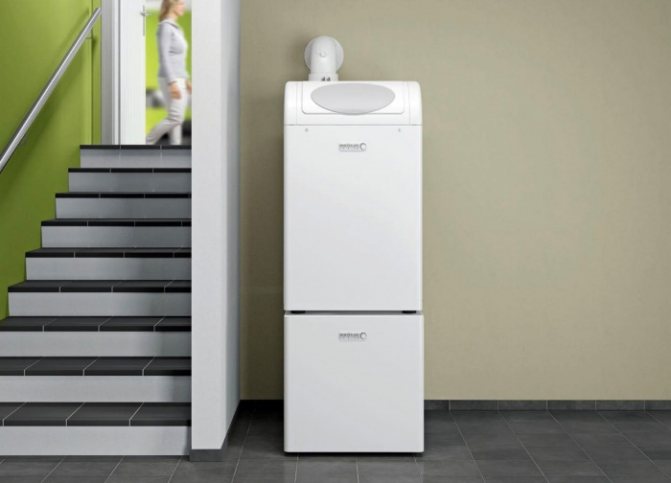

If such characteristics of the product are still enough, you can choose boilers from the ones presented below. They differ in design features and execution options:
- Wall mounted boiler with an open chamber. This option is rarely chosen. When choosing it, it should be borne in mind that such designs are the cheapest. In the case of regular power outages, such a boiler is ideal.
- Floor-standing product equipped with an open chamber. In this case, the installation of a floor structure is required. Cast iron heat exchangers are used in such devices. They are very durable and corrosion resistant.
- Wall-mounted construction with a closed combustion chamber. Such devices are characterized by the complexity of the electronic filling. Therefore, the products are sensitive to voltage surges. Also, only high-quality water should be used for them.
- Floor standing boilers with a closed chamber. These products are quite expensive.
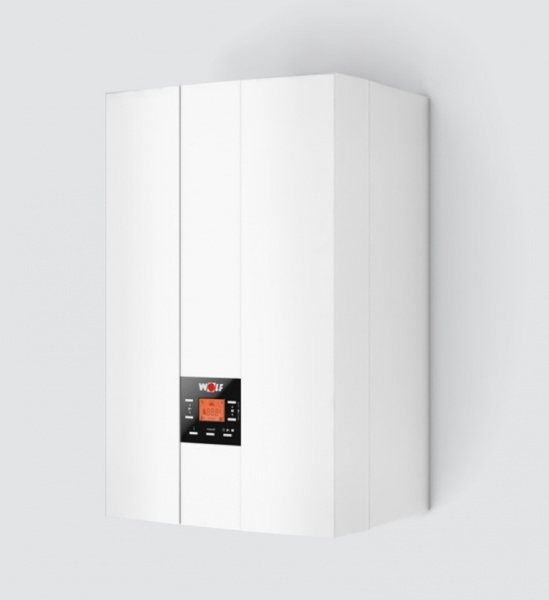

Having dealt with the types of the boiler, you can begin to study other parameters. Products from Russian manufacturers are of good quality. Products with a capacity of 24 kW are more in demand. Stands out among manufacturers
Features and principle of operation of an atmospheric boiler in comparison with a turbocharged one
The atmospheric boiler is equipped with an open combustion chamber. Air intake occurs naturally, and combustion products are evacuated through the chimney using draft. Since the combustion chamber is leaking, some of the gases enter the environment, which can lead to poisoning. That is why atmospheric boilers are installed in separate technical rooms with good ventilation.

